10 Early Civilizations in the Near East
Mieko Matsumoto; Charlotte Miller; and Cynthia Smith
INTRODUCTION
OVERVIEW
This chapter focuses on early civilizations in the Near East, in an area sometimes called the Fertile Crescent. The civilizations in these regions left written records. They also all initially had economies based on farming and developed alongside rivers. Their locations alongside rivers allowed populations in these regions to grow the surplus food that they used to support urbanization, social stratification, labor specialization, and trade.
MESOPOTAMIA: THE LAND BETWEEN THE RIVERS
The first farming villages were sedentary extensions of kinship-based foraging societies. In places like Çatal Huyuk in the Fertile Crescent of Anatolia (what we now call Turkey), communities continued to supplement agricultural activities with nearby foraging for a very long time after their inception. In Çatal Huyuk, houses had shared walls used for defense and storage rooms designed to preserve grains and other agricultural products. As agricultural abilities evolved, so too did the needs of growing communities. As populations grew, more cropland was needed. As more land was cleared and marginal land was put under the plow, environmental problems accelerated. Rainfall was eventually not sufficient to water the crops needed to feed such large populations. The overuse of the land for crops without time to recover led to decreasing productivity, and over time, decline of the earliest settlements. Over the long term, these problems led to the desertification of much of the region. In the river valleys of Mesopotamia and Egypt, however, more reliable sources of water – primarily irrigation from the large Tigris and Euphrates Rivers – and fertile land were available. This made them capable of supporting sustained, large-scale farming and urban populations in ways that other parts of the Fertile Crescent were not. Thus Çatal Huyuk remained a small village, and the momentum of ‘civilization’ shifted to Egypt and Mesopotamia.
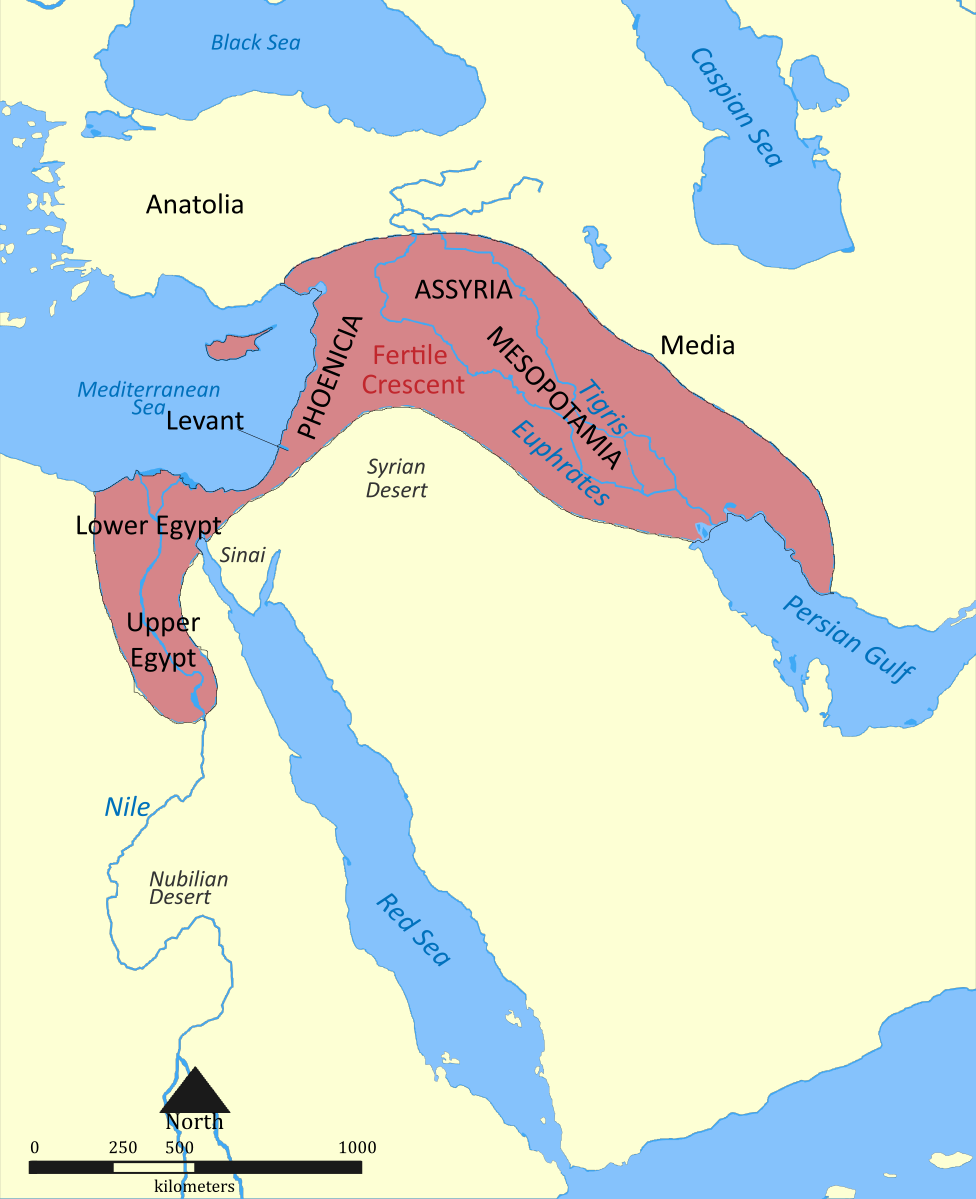
Mesopotamia is located in an area known as the Fertile Crescent. Archeologists have found some of the earliest known sites of agricultural production in the Fertile Crescent. Although much of this region received little or irregular rainfall, the Tigris and Euphrates Rivers provided large amounts of freshwater, facilitating agricultural production and the development of early civilizations. The Greeks later recognized the significance of the river systems to these ancient societies and referred to the region as “the Land between the Rivers” or Mesopotamia. The Tigris and Euphrates flow south, emptying into the Persian Gulf, with water from these rivers finding its way into small channels, eddies, and streams and irrigating the fertile silt deposited in seasons past. The richer soils and availability of water from these rivers benefited areas that in the north had little rain, or in the south had months of rainfall followed by long, dry spells; this water supply encouraged settlement near the rivers. The areas closer to the Persian Gulf, known as Lower Mesopotamia, were particularly attractive to early settlers because they had extremely fertile soils. It was here that Mesopotamians built some of the earliest cities, including Uruk, Eridu, and Ur.
While the Tigris and Euphrates Rivers did provide water to the region, their floods were unpredictable and could even be catastrophic, washing away entire settlements. In response, the region’s residents created irrigation canals and drainage ditches to control the flow of water. They also stored water in reservoirs to use during the dry months of the year. Additionally, in parts of Lower Mesopotamia, the courses of the rivers and their tributaries changed frequently, so people either had to move to follow the water’s new path or divert a river to continue supplying water for their settlement. As regular access to water supported agricultural surpluses and population growth, people tended to fare better against the unpredictability of the floods, seasonal changes, and the rivers’ changing courses when they lived in settlements capable of maintaining irrigation canals, drainage ditches, and water reservoirs.
These rivers provided multiple crucial benefits to the Mesopotamians. In addition to providing life-sustaining water, the rivers enabled regional and long-distance trade and transportation. While people made use of local resources, like mud to build their homes, in general, Lower Mesopotamia lacked other desired resources, including wood, stone, and precious metals. Traders were able to use the rivers to bring in these resources from Assyria, Anatolia, the Levant, and areas adjacent to the Persian Gulf. Early Mesopotamians also obtained goods from as far away as modern day northern Pakistan and India. Merchants used overland routes that crossed the Iranian Plateau and sea routes, exchanging Mesopotamian products like grains and textiles for luxury goods from the east. Royal cemeteries show that by 2,500 BCE Mesopotamian elites were buried with a variety of imports, including beads brought from the Indus River Valley. The rivers and the overland trade routes also facilitated communication and, with it, the sharing of ideas and technologies.
By 3,500 BCE, cities emerged in the region of Lower Mesopotamia, known as Sumer (today Southern Iraq), which is centered in the delta region where the Tigris and Euphrates rivers meet and flow into the Persian Gulf. Those who settled here enjoyed the benefits of river water as well as lakes fed by underwater reservoirs. The region boasted verdant green marshlands home not only to plants, but to birds, freshwater fish, and numerous other animals. Lands made fertile from river water produced crops that fed growing cities. This is where the first cities in human history were built with trees brought from the Mediterranean coast of what is today Lebanon, and mud bricks formed in molds with reeds to strengthen them, then baked in the sun to harden. Many of those bricks still exist in the remains of ancient structures. Cities featured both planned urban spaces (including temples, palaces, and other public buildings) and unplanned spaces, for example, dense urban residential areas that featured homes that lacked consistent orientation and shape, alongside streets that lacked uniformity, paving, and drainage.
Massive construction projects, including planned urban spaces and complex irritation networks, required management of labor, as well as developed knowledge of engineering and geography. Division and mobilization of labor, under a clear hierarchical leadership, enabled direction, planning, and logistical organization. Here, for the first time, an organized and well-planned system of planting, harvesting, and distribution made it possible for a minority of the population to produce the food to support others who pursued labor specializations not solely focused on supplying food. Agricultural harvests for Mesopotamian cities like Ur, Lagash, Uruk, and Eridu were sometimes so productive that one farmer could feed one hundred people. This agricultural productivity allowed for the growth of the world’s first urban centers and the systems necessary to support them including: development of extensive public works, organized government and religious systems, law, entertainment, markets and trade, and education. Urbanization also meant poverty, crime, slavery, waste, social classes, and warfare. For the first time, people had to devise methods and ideas with which they could enjoy the benefits of cultivated agriculture and large city groups, while also getting along with one another in social situations far more complex than tribal kinship groups.
THE SUMERIAN CITY-STATES
In Lower Mesopotamia, or Sumer, the environment drew settlers who took advantage of rich soils and the availability of water in the area. Prior to 3,000 BCE, Sumerians, whose origins remain a subject of debate, founded a number of independent cities in Lower Mesopotamia. In these cities, Sumerians had organized religions, centralized governments, social hierarchies, and access to trade networks. As these cities expanded, their leaders claimed control over adjacent territories, forming at least a dozen city-states, which became the basic organizational structure of Sumerian civilization in the 3rd millennium BCE. By incorporating the surrounding territories into city-states, urban centers were able to draw on more resources.
Sumerian cities had certain characteristics in common. First, a temple complex or a ziggurat was usually the visual focus of the urban landscape. Sumerians believed that their entire city belonged to its main deity, and built a massive temple, the most important building in the city, to be the dwelling place of their city’s main god or goddess. This was a complex that comfortably housed many of the priests and priestesses who served the city’s deity surrounded each temple. In addition to attending to the religious needs of the community, temple complexes also owned land, managed industries, were involved in trade, and acted as banks. Their wide-ranging roles meant that temples often had additional outbuildings, like granaries and storage sheds, in the surrounding countryside.
Sumerians practiced polytheism, meaning they worshipped multiple gods and goddesses. Because Sumerians believed each god had a family, they also built smaller shrines and temples dedicated to these divine family members. Each city would have a number of temples while many Sumerian homes had small altars dedicated to gods. Sometimes, urban temples or ritual spaces were built atop a ziggurat, a solid rectangular tower made of sun-dried mud bricks.
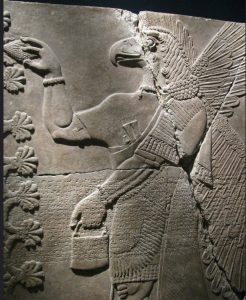
Archeological evidence shows that temple complexes were expanded and rebuilt over time and, by the late 3rd millennium BCE, temples in many of the Sumerian city-states were raised on platforms or else situated on a ziggurat. The towering architecture of the ziggurat stressed the significance of the temple to the surrounding community. One well-preserved ziggurat, the Great Ziggurat of Ur, was constructed with an estimated 720,000 baked bricks and rose to a height of about 100 feet. The people of Ur constructed this ziggurat for their patron deity, the moon goddess Nanna. They likely brought regular offerings to Nanna and also received food rations from the Great Ziggurat. The ziggurat consisted of three terraces, topped with a temple, built of mud brick. It was built by King Ur-Nammu around 2,100 BCE. Excavations in the 1920s CE revealed that the first terrace of the ziggurat alone required over 700,000 bricks, demonstrating the incredible amount of resources, organization, and human labor required to undertake such a massive building project. The temple at the top of the ziggurat honored the patron god of the city of Ur, Nanna.
Archaeologists believe cities developed in Mesopotamia slowly. Archaeological surveys of Mesopotamian cities have revealed that cities were frequently rebuilt on top of earlier settlements. For example, in the ancient city of Eridu, a great ziggurat was built upon the ruins of other temples. Each time a fire, flood, or earthquake destroyed the city, the city itself and the temple were rebuilt using the ruins and rubble of the previous construction as the foundation for the new one. This practice has allowed archaeologists to dig through layers of Eridu and reconstruct its physical history.
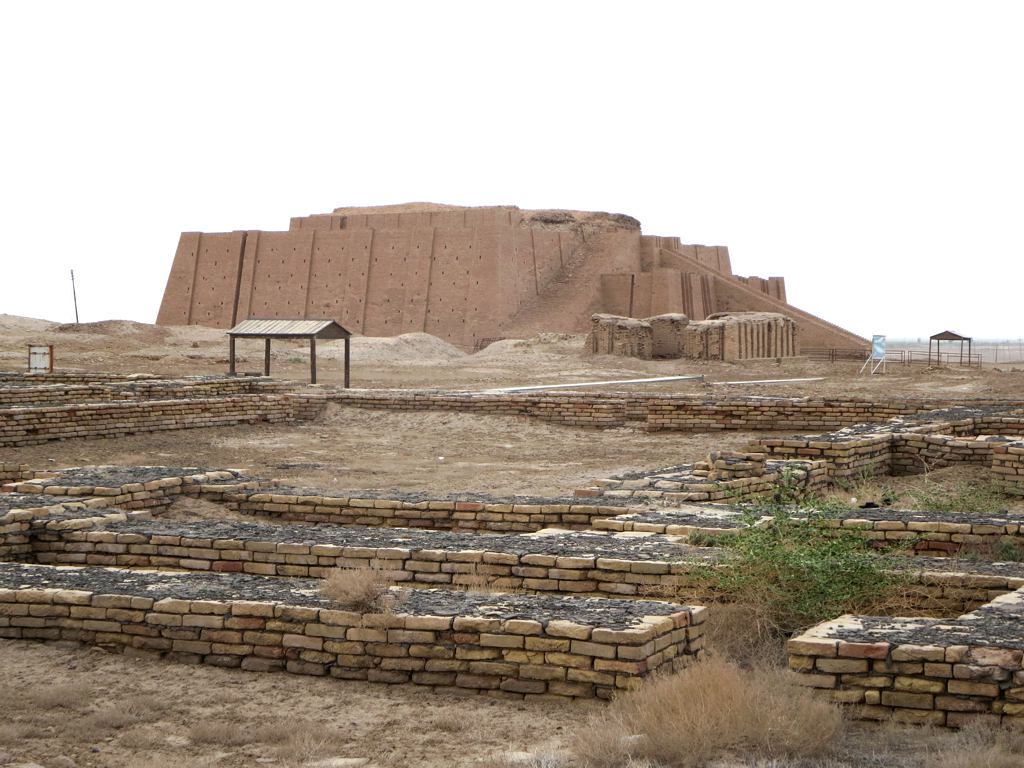
The Sumerian worldview was of a pantheon of gods and goddesses ascribed responsibility for nearly every event in nature. Viewing nature as unpredictable, people brought offerings to their city’s temple complexes or ziggurat, hoping to please the gods who controlled the natural forces of their world. Priests and priestesses collected and redistributed the offerings, demonstrating the vital roles they played in Sumerian society. Those whose specialized task it was to understand the gods, trained in religious rites and special religious knowledge, were elevated to the top rung in society. The relatively privileged position of priests and priestesses at the temple complex reflects the development of social stratification (a hierarchy) in Sumeria and demonstrates how agricultural surpluses supported the specialization of labor. In fact, some of the early leaders of Sumerian cities may have been “priest-kings,” attaining elevated positions through their association with the temples. The later rulers of city-states supported the temples, claiming to be acting on behalf of the gods who brought divine favor to their followers.
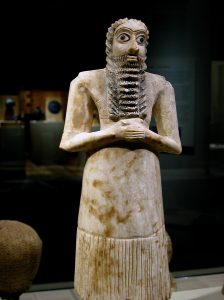
Sumerian city-states had local rulers who lived in large palaces. So far, archeologists have dated the earliest known royal palaces to c. 2600 BCE and concluded that Sumerian city-states had centralized governments with secular rulers by at least that time frame. While there does seem to have been a sense of inhabiting a shared space in Southern Mesopotamia, referred to as “the Land” in written records, city-states had distinctive identities. In part, their distinctive identities revolved around their main deity.
The rulers of city-states alternately supported, competed with, and fought against one another. The Sumerian King List, a manuscript that listed early kings and described their reigns (with some presumably fictive and exaggerated elements), provides evidence of alliances, competition, and war. For example, it describes En-mebarages as the second to last king of the 1st Dynasty of Kish, “…who carried away as spoil the weapons of the land of Elam, became king, and reigned 900 years…”[ ] (Postgate 1994, 28). While En-mebarages certainly did not rule for 900 years, this statement reflects the importance of military ability in legitimizing claims to kingship.
Furthermore, the Sumerian King List recognized only rulers who had established control over multiple city-states as kings (with the title of lugal in the Sumerian language) belonging to distinct dynasties. While it lasted, a dynasty generally passed down the kingship through the male line. According to the Sumerian King List, the seat of power, held by hereditary kings, shifted from city-state to city-state with the rise and fall of dynasties through the 3rd millennium BCE. Significantly, the Sumerian King List began its recorded history “when kingship came down from heaven,” legitimizing secular kings through their association with gods. (Postgate, J.N. 1994, 28). Sumerian kings, often along with local rulers, led armies, collected taxes, organized labor for state projects, and meted out justice. At the top of the hierarchy and with control over multiple city-states, kings expected obedience from local rulers and their subjects, and support from the priests and priestesses of the temples.
The historical record makes clear that kings, local rulers, priests, and priestesses held influential positions in Sumerian societies. However, these elites were the minority of the population; farmers made up an estimated 90% of the population. Other skilled people included animal-breeders, merchants, craftspeople, fishermen, doctors, soldiers, architects, and scribes. Surplus agricultural production collected as tribute, as well as wealth generated by trade, supported such labor specialization. One important outcome of labor specialization was innovation in metalworking. By approximately 2900 BCE, metalworkers began producing bronze, which was stronger than copper. Stronger weapons and farming tools gave Sumerians advantages when it came to combat and agricultural production.
As Mesopotamian cities increased their wealth and populations through productive agriculture, they also improved prosperity through increased trade. Merchants helped the people of Sumer, in cities such as Uruk, Lagash, Eridu, Ur, procure materials and goods needed such as timber for building and boats, metal for ceremonial objects, plows and weapons, salt for food and livestock, and other tools and objects that improved the efficiency of Sumerian civilization. Finding markets for Sumerian products meant making contact with other groups of people outside of Sumer. For example, Jericho, on the edge of the Dead Sea, traded salt, one of the most precious commodities in the ancient world. Çatal Huyuk, a Neolithic village on the slopes of a volcano in what is today Turkey, became a trading partner of Sumerian city-states and dealt in obsidian, a volcanic glass prized as a cutting edge for tools. Through trade, communication and interchange expanded between diverse cultural groups who exchanged their different languages and ideas, as well as goods.
The movement of goods necessitated the creation of transportation systems between cities. Roads, canals, and bridges leading to Sumer were built to facilitate trade. Merchants eventually traded with communities as far west as Egypt and perhaps Central Africa, as far south as what is now called Yemen, north into the Caucasus regions, and east as far as the Indus Valley. The role merchants played reached far beyond simple economics. They brought greater material wealth as well as blazed trails that made the people of Sumer aware of a broader world of ideas and goods.
Although increasing agricultural productivity and trade improved quality of life for Sumerians, the benefits of such prosperity were not accessible to all in a society with structured inequalities. The first civilization gave rise to the first slave system. Individual Sumerians and institutions, including temples, owned slaves. Slaves performed a variety of tasks such as construction, weaving, agricultural and domestic labor, tending animals, and even administrative work as scribes. Some slaves were chattel slaves, meaning that society treated them as property with no rights. Usually, chattel slaves were prisoners of war or slaves bought from outside communities. They were branded by barbers or tattoo artists and forced to work at the will of their masters. If they tried to run away, the law required slaves to be returned. The more widespread type of servitude in most Sumerians societies was likely debt slavery, which was generally temporary, lasting until a debtor paid off a loan and its interest. Over the past century or so, archeologists have added a great deal to our understanding of Sumerian social distinctions through their work at numerous excavation sites, but many gaps in our knowledge still exist.
Learning in Action – Ancient Mesopotamia
Watch the video: “Ancient Mesopotamia 101”, National Geographic 2022
Link: https://www.nationalgeographic.org/video/ancient-mesopotamia-101/
THE MESOPOTAMIAN WRITTEN RECORD
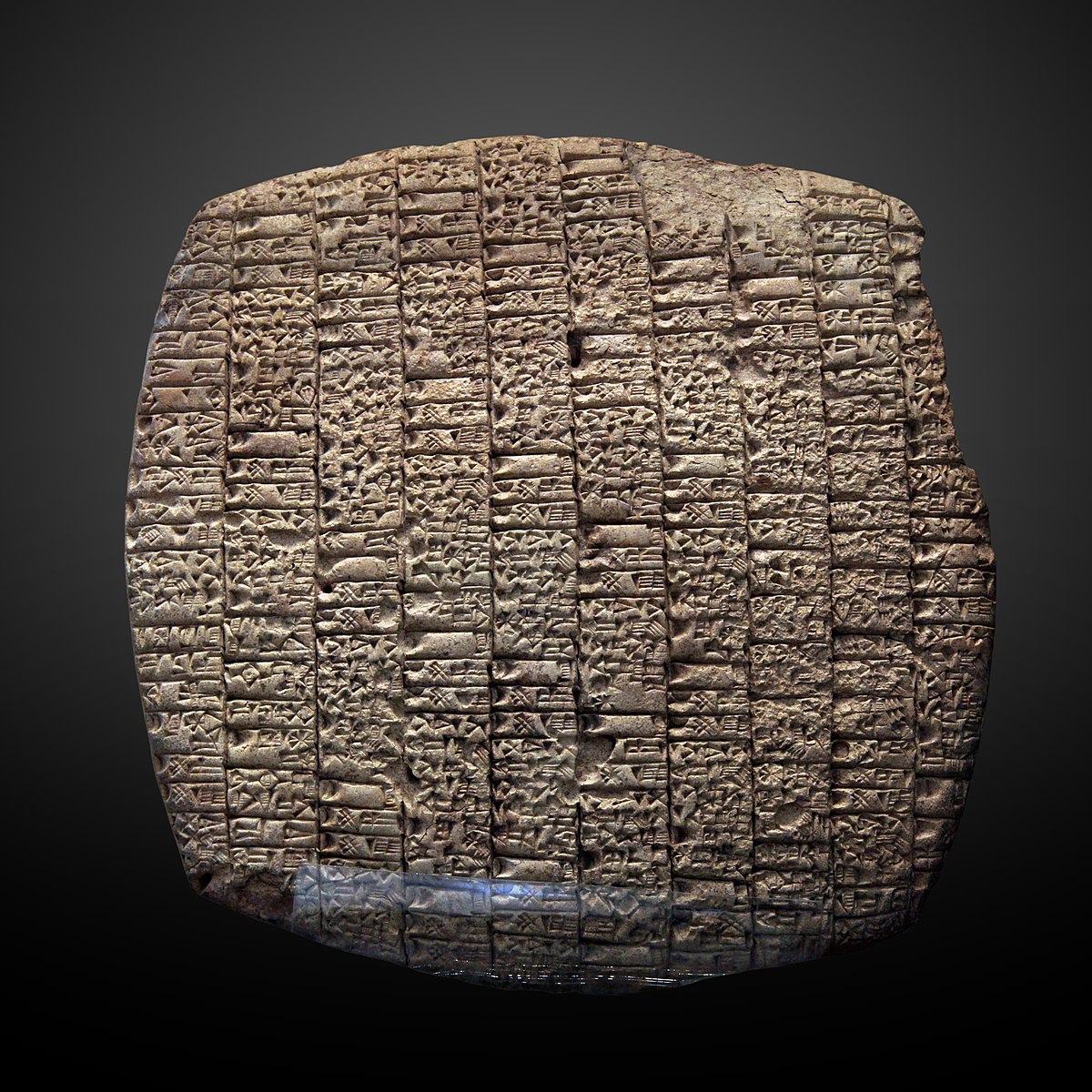
Key to understanding Mesopotamian society is reading their written records. This first written system in history was initially little more than notches on sticks. Eventually Sumerians drew pictures in clay tablets to resemble objects, which evolved into a written system. These records were primarily for keeping records of goods for trade and tax purposes. This was a pictographic style of writing, a form of symbolic writing also used in many places in the world. A limitation of pictographic writing is that while pictures can depict objects and simple actions, they are less effective at expressing complex ideas.
By 3,200 BCE Sumerians had developed a new form of record keeping, a written script called cuneiform. Cuneiform is named for the triangular shaped impressions left behind by the reeds that were used in writing. The writer used a reed stylus to make indentations in clay. Once baked, these tablets proved to be remarkably hardy and long lasting. The archeological discovery of cuneiform tablets at Mesopotamian sites has greatly expanded our understanding of Sumerians. Cuneiform was used to keep records such as financial transactions, legal proceedings, administrative decisions and political records as well as preserving legends, chants, and prayers. Cuneiform was also used to create the Sumerian King List. The vast majority of the Sumerian population were not literate, and written records were written by and produced for the elite. These elite were primarily male, which complicates our understanding of the experiences of Mesopotamian women.
The development of cuneiform led to the creation of a new form of labor specialization, the scribes. Scribes who had been specially trained in scribal schools generated many of the records. While in school, in addition to copying written passages, scribes learned arithmetic. The Sumerians system of arithmetic was based on the number 60, which we still use to divide time into hours, minutes, and seconds. This record keeping also led to the creation of an extraordinarily useful tool, the calendar. Knowledge preserved in early calendars was controlled by the priesthood, another source of tremendous power and even profit. In addition to specially trained scribes, merchants learned and used cuneiform as a means of record keeping, and to facilitate long-distance trade negotiations.
Learning in Action – Writing Cuneiform
Watch the video: “Writing Cuneiform,” excerpted from “The Cyrus Cylinder”, The British Museum 2014
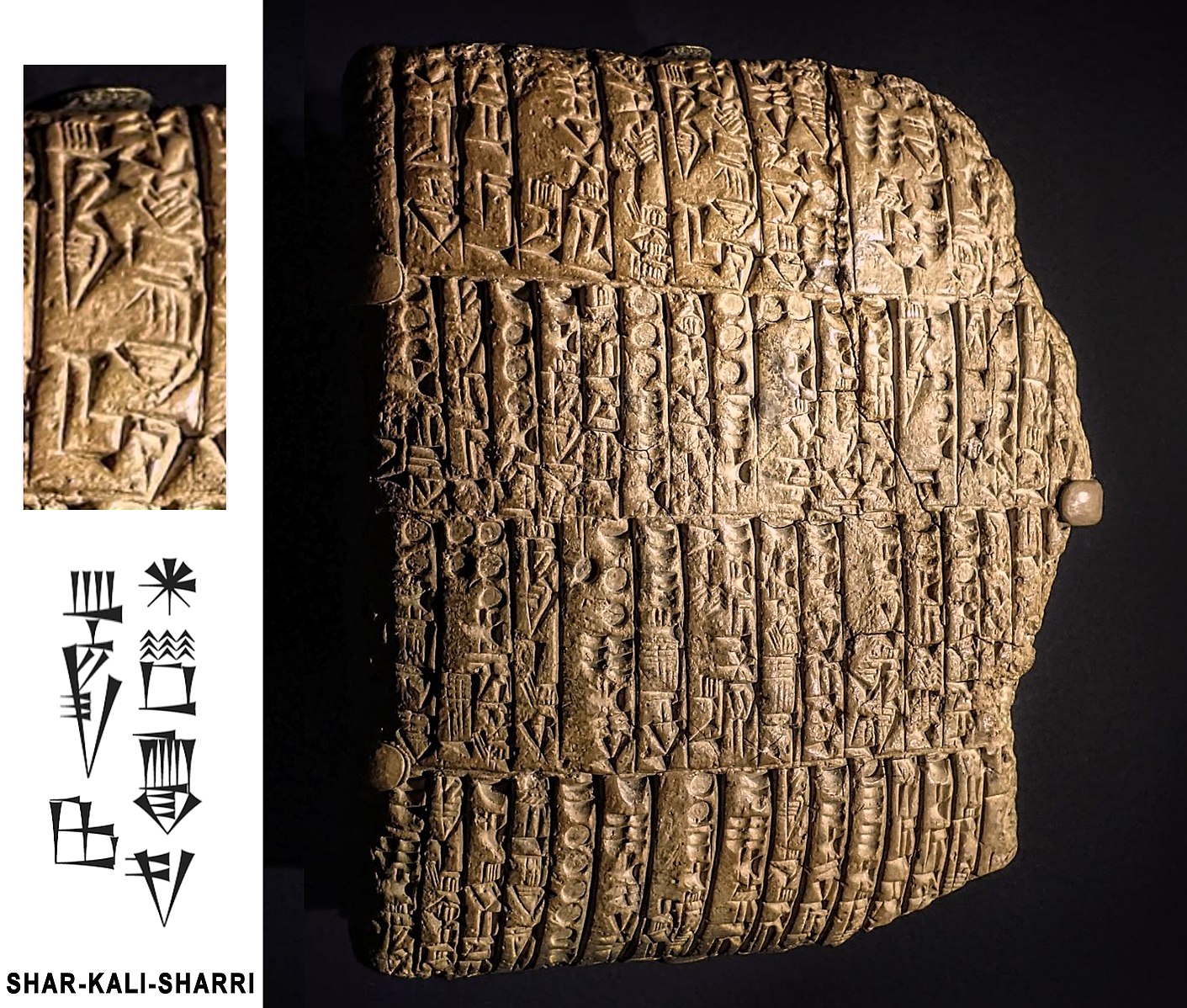
Using archeological and written evidence, scholars have pieced together what they can about everyday life for Sumerians, though questions remain. For instance, it has been a challenge to determine the layout of urban spaces beyond the prominence of the temples and the relative grandeur of palaces. From archeological finds, scholars suspect that Sumerian cities were divided into neighborhoods by occupation and according to kinship groups, but uncertainties about specifics linger. Legal documents and tax records show that people owned property in both the cities and the countryside. Also, evidence suggests social stratification, as some Sumerians owned fairly large chunks of land, while others had much smaller plots or presumably no land at all. Wills, court proceedings, and temple documents show that land and temple offices were usually bought, or else acquired through military or other service to the state. A man inherited land, property, offices, and their attendant obligations to the state (such as reoccurring military service) from his father. The eldest son seems to have frequently inherited a larger share than younger brothers and have been given control over the family home. He was tasked with performing regular rituals to honor dead ancestors, who were usually buried underneath the home. From the written documents, we also get glimpses into other aspects of Sumerian life, like marriage and divorce.
Sumerians viewed marriage as a contract between two families and, as a result, the male heads of the two families arranged a couple’s marriage. Documents show that both families contributed resources to seal the union or complete the marriage contract. The man’s family gave gifts or money and hosted a feast, while the woman’s family amassed a dowry. Although a woman did not automatically receive an inheritance upon the death of her father, she could expect to receive (and use the court system to make sure she got) a dowry, even if it came from her father’s estate after his death. Divorce was possible but sometimes led to social ostracism or even punishment if there were accusations of misconduct, such consequences being especially the case for the woman. Records indicate that polygamy was not common, but wealthier men did keep slave girls as concubines. Overall, Sumerians considered marriage an essential institution in that it brought families together and ensured the continuation of the family lineage.
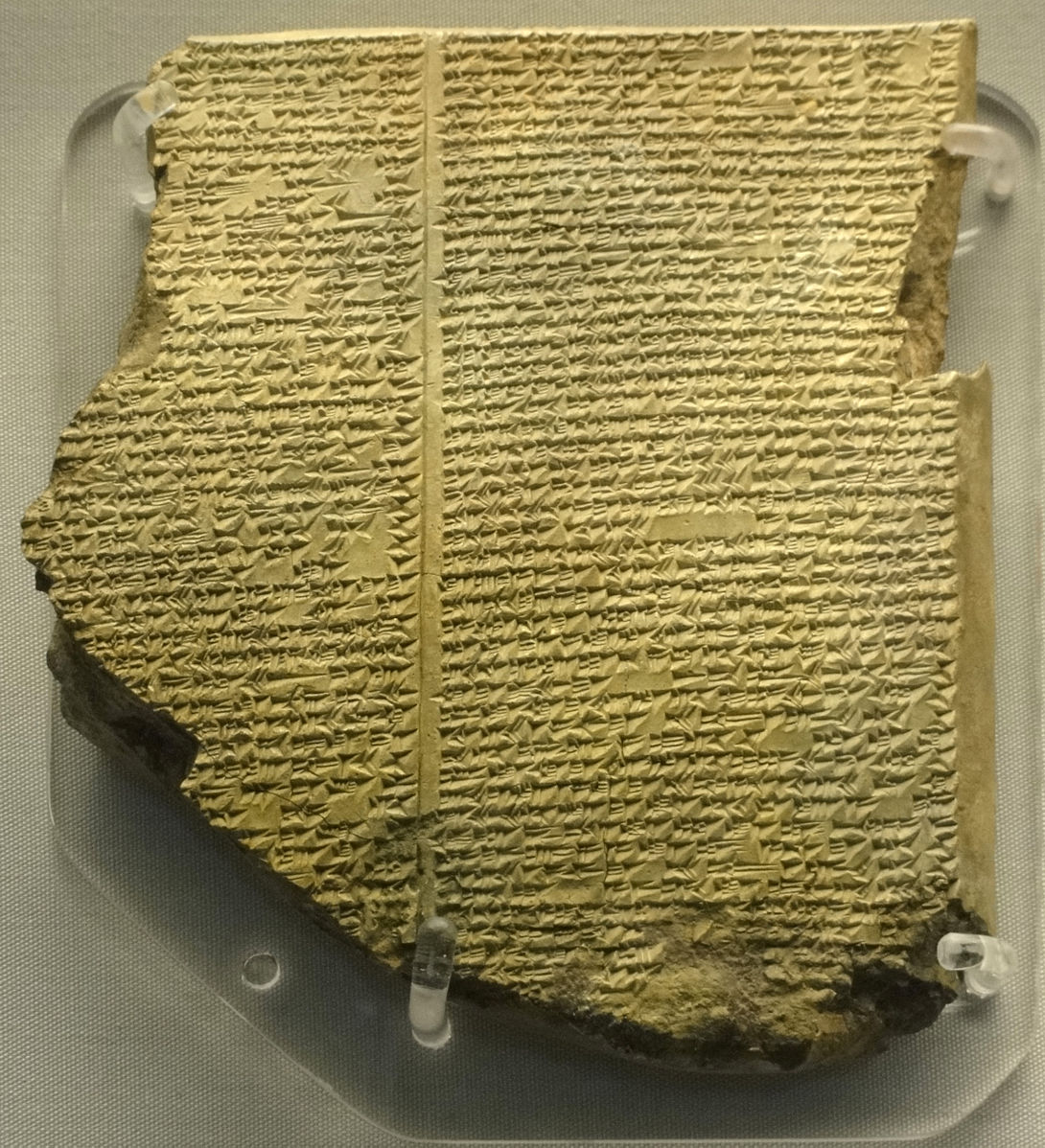
Legends, myths, poems, and literary texts tell us about Sumerians, too. For example, we can explore their values and views of the afterlife through reading The Epic of Gilgamesh. The Epic of Gilgamesh relates the adventures of Gilgamesh, a legendary king, who may have lived around 2,700 BCE. The epic has multiple versions and was passed on orally before it was first written down in cuneiform in about 2,000 BCE. The epic follows the heroic exploits of Gilgamesh and his companion, Enkidu, to emphasize the importance of values such as loyalty and humility. In one section, the epic describes a very gloomy afterlife where “people see no light, they sit in darkness,” reflecting Mesopotamian beliefs that the afterlife was miserable for all, even those who had lived virtuously (Sandars 1960, NP). Additionally, it portrays the environment as potentially violent and hostile as in its flood story, which in some ways resembles the account of Noah and the flood found in Genesis. Ultimately, Gilgamesh fails at his quest to find eternal life but learns to work for the glory of the gods and for worthwhile human achievements.
Other archeological finds and written documents also give some hint of the broader popular culture and artistic conventions in ancient Mesopotamia. For example, cuneiform tablets with pictures of dancers and singers, as well as instruments found in graves, suggest that Sumerians placed importance on music, using it for entertainment and ritual purposes. Trying to learn more about Sumerian music, scholars and other enthusiasts have replicated Sumerian instruments and presented their best estimation of Sumerian scales and tuning. The documentary evidence suggests that hymns from the ancient Sumerian city-states were shared with later Mesopotamian empires and even spread into the Mediterranean world.
Reading the Past – The Epic of Gilgamesh
Read: an excerpt from The Epic of Gilgamesh, Trans. N.K. Sanders (Baltimore: Penguin, 1960), 108-113.
Link: https://college.cengage.com/history/primary_sources/west/the_epic_gilgamesh.htm
THE MESOPOTAMIAN EMPIRES
In the second half of the third millennium BCE, Sumerian city-states fought each other, and dynasties rose and fell. Kings consolidated power over multiple city-states in the region. Then, King Sargon of Akkad enlarged the scale by conquering the Sumerian city-states and parts of Syria, Anatolia, and Elam. In doing so, he created one of the world’s first empires in approximately 2,334 BCE. For generations, Mesopotamian literature celebrated the Akkadian Empire (c. 2,334–2,100 BCE) that King Sargon founded. Like the Akkadian Empire, three subsequent empires, the Babylonian Empire (c. 1,792–1,595 BCE), the Assyrian Empire (c. 900–612 BCE), and the Neo-Babylonian Empire (c. 605–539 BCE), also ruled large parts of Mesopotamia and the Fertile Crescent.
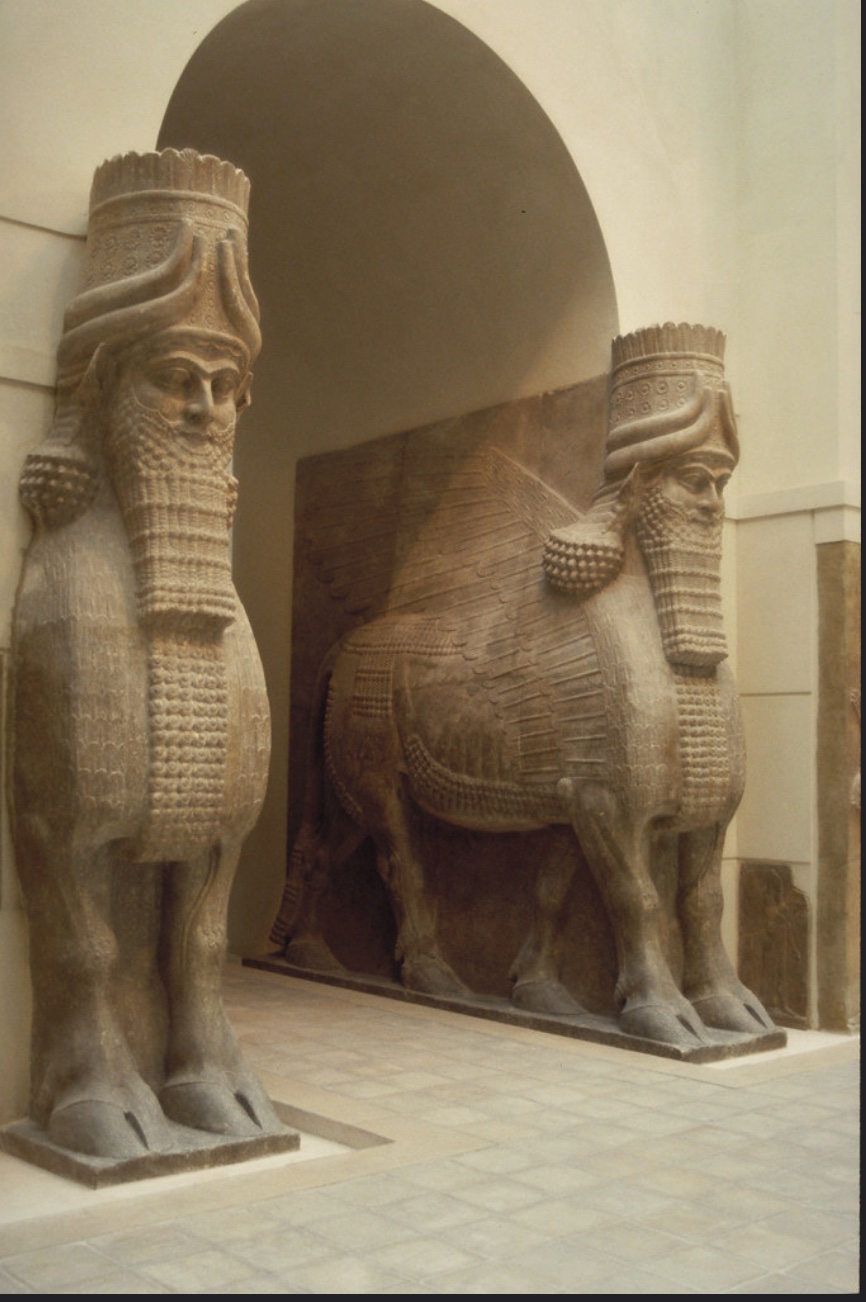
The Akkadian Empire (c. 2334-2100 BCE)
Sargon of Akkad (ruled c. 2334–2279 BCE) founded the first empire in Mesopotamia. From his allegedly humble origins, Sargon of Akkad conquered Sumerian city-states one by one, creating an empire encompassing numerous states, ruled by a single authority. Archeologists have not found the empire’s capital city, Akkad. However, from the available information, archeologists have estimated its location, placing it to the north of the early Mesopotamian city-states Ur and Sumer. It is clear that Sargon of Akkad turned the empire’s capital at Akkad into one of the wealthiest and most powerful cities in the world. According to documentary sources, the city’s splendor stood as another symbol of Sargon’s greatness. The city grew into a cosmopolitan center especially because of its role in trade. Akkadian rulers took advantage of trade routes that extended as far as India by seizing and taxes traded items. Sargon ruled the empire for over fifty years. His sons, grandson, and great grandson attempted to hold the empire together but after about 200 years, attacks from neighboring peoples caused the empire to fall. After the fall of the Akkadian Empire, Hammurabi founded the next empire in the region in 1,792 BCE.
The Babylonian Empire (1792-1595 BCE)
Hammurabi, who aspired to follow Sargon’s example, created the next empire in the region, the Babylonian Empire. With well-disciplined foot soldiers armed with copper and bronze weapons, he conquered Mesopotamian city-states, including Akkad and Sumer, to create an empire with its capital at Babylon. Hammurabi improved infrastructure, promoted trade, employed effective administrative practices, and supported productive agriculture. For example, he sponsored the building of roads and the creation of a postal service; he also maintained irrigation canals and facilitated trade all along the Persian Gulf. After Hammurabi’s death, his successors lost territory. The empire declined, shrinking in size. The Hittites, from Anatolia, eventually sacked the city of Babylon in 1,595 BCE, bringing about the official end of the Babylonian Empire.
Hammurabi is most famous for the law code etched into a stele that bears his name, the Stele of Hammurabi. The Stele of Hammurabi records a comprehensive set of laws. Codes of law existed prior to Hammurabi’s famous stele, but Hammurabi’s Code was still intact and has proven very influential. As seen in the image below, the upper part of the stele depicts Hammurabi standing in front of the Babylonian god of justice, from whom Hammurabi derived his power and legitimacy. The lower portion of the stele contains the collection of 282 laws. One particularly influential principle in the code is the law of retaliation, which demands “an eye for an eye, a tooth for a tooth.” The code listed offenses and their punishments, which often varied by social class. While symbolizing the power of King Hammurabi and associating him with justice, the code of law also attempted to unify people within the empire and establish common standards for acceptable behavior.

Reading the Past – Hammurabi’s Code of Laws
Read: an excerpt from “Hammurabi’s Code of Laws”, Translated by L. W. King 1998
Link: https://legacy.fordham.edu/ halsall/ancient/hamcode.asp#text
Environment in History – The Environmental Impact of Agriculture in Mesopotamia
Mesopotamian societies were the ‘first’ in many areas of innovation in social, political, economic and technological areas. These settlements also provide early evidence of the destructive influences of intensive agriculture and urban life on the environment. Cultivation of the soil and use of animal agriculture generated significant surpluses and supported dense, increasingly complex societies. But agriculture also meant intensive pressure on natural resources. These costs of agriculture were immediately apparent with this first great civilization. Over time, pressure to produce ever-increasing yields to feed growing populations led to soil degradation through depletion of nutrients, overgrazing and soil salinization. Use of irrigation means water is distributed on fields; when that water evaporates, especially in a hot, semi-arid region, it leaves behind salt accumulations, significantly reducing soil fertility. In Mesopotamia, salt was also brought down from mountains by the rivers and deposited during times of flooding, reducing soil fertility and integrity over time. Lack of drainage in some areas exacerbated the problem. Soil in these areas became waterlogged, causing the water table to rise and bringing more salt to the surface.
Consistent, intensive farming led to problems with salinization and decreased wheat yields, concerns written about by Sumerians early in their history. Salt deposits and declining yields were described in Mesopotamian records as early as 2,400 BCE. Ancient Sumerian texts bemoan the decline in wheat production, visible salinization in the fields and reduced harvests. There were even reports of fields being abandoned due to salinization. Sumerians were initially equally dependent on wheat and barley crops for sustenance. Barley was a key ingredient in Mesopotamian beer, the drink of choice for Sumerians. By 1700 BCE Mesopotamian soil underwent a prolonged period of salinization that eventually resulted in Sumerians abandoning wheat for barley, a crop that could withstand higher levels of salinity. To alleviate their problems, Mesopotamians would have needed to allow fields to lay fallow for years, a practice that ran counter to the food and economic needs of the growing population. Rulers of city-states were reliant on an ever increasing population to provide farmers and soldiers.
Additionally, clearing forests exacerbated environmental decline. Deforestation was carried out to create open land for cultivation and to create grazing pastures for domestic animals. As trees and wild grasses were cleared, this left soil more vulnerable to flooding and salinization, as well as wind and rain erosion. Deforestation also reduced moisture in the environment, accelerating the shift to hotter, drier conditions which reduced crop yields. Mesopotamian cities grew for centuries and over time silt from these two great rivers turned fresh water sources into lakes of sand; over-farming turned soil into acidic, salinized dirt, and deforestation reduced moisture in the atmosphere, intensifying soil and wind erosion. As the soil quality declined, crop yields dropped including yields of barley, resulting in malnutrition which rendered populations more susceptible to disease. These were the perfect conditions for political instability and conflict as ordinary people revolted and struggling rulers went to war in search of more fertile land.
These human-created environmental problems did not destroy this civilization. Mesopotamia did not collapse from degradation of the environment as some later civilizations did. But the struggle to extract from nature to feed cities and intensive consumption patterns did result in some cities becoming depopulated. And over centuries, the soil and agricultural productivity of this region declined dramatically. Environmental pressures of farming and urban living were clearly evident in this first agriculturally based society, adding to social, religious and political complexities inherent in this experimental new way of living. Today, the cumulative effects of a heavy human presence on the land in this first cradle of civilization is starkly apparent as sites that were home to tens of thousands of ancient peoples, fed by fertile lands, are today barren deserts. These environmental challenges continued to be seen in later agricultural societies and haunt us still.
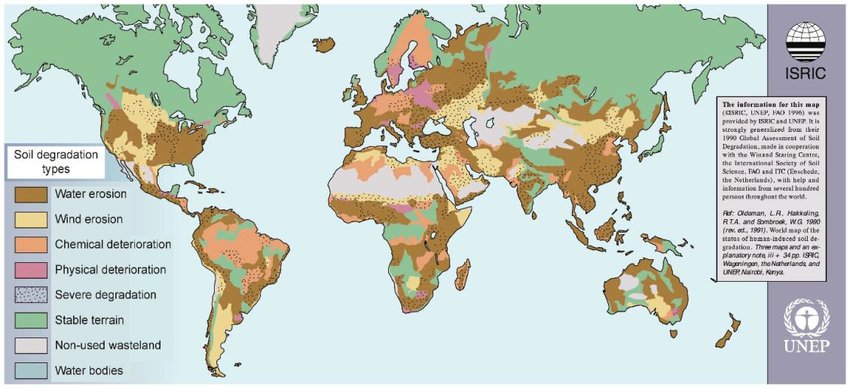
Learning in Action – Climate Refugees Past and Present
Read: “How Climate Change Caused the Worldʻs First Ever Empire to Collapse,” The Conversation 2019
Read: “The Refugees The World Barely Pays Attention To,” Tim McDonnell, NPR 2018
THE MIDDLE/NEAR EAST BEYOND MESOPOTAMIA AND EGYPT
Mesopotamia and Egypt emerged in the 4th millennium BCE, creating the first great cities and achieving myriad influential innovations. Centuries later, around 2,000 – 1,800 BCE, several other agriculturally-based cultures appeared in surrounding regions, expanding this new model of civilization from the Tigris/Euphrates and Nile River valleys throughout the ancient Near East. The ancient Near East (also referred to as the Middle East or Fertile Crescent) encompassed territory from Egypt to the Tigris-Euphrates river valley, extending as far north as Anatolia (modern day Turkey.) Agricultural settled societies flourished after the 2nd millennium BCE throughout this ancient Near Eastern region.
Historians use different terms to categorize these later-developing civilizations in the ancient Near East. The term ‘satellite’ civilizations reflects the fact cultures were deeply impacted by older, established neighbors Egypt and Mesopotamia. The term ‘rain watered’ civilizations underlines the fact most later agricultural societies in the ancient Near East were not based around great rivers and emerged only after technological advances made possible irrigation based on rain water. Technological capabilities necessary to capture, store and distribute rainwater were not available until after 2,000 BCE. Only at this point did rain-watered civilizations emerge and make their presence felt in world history. Religious ideas, goods, and people crossed borders, contributing to shared cultures and regional history. We address some of these influential peoples below.
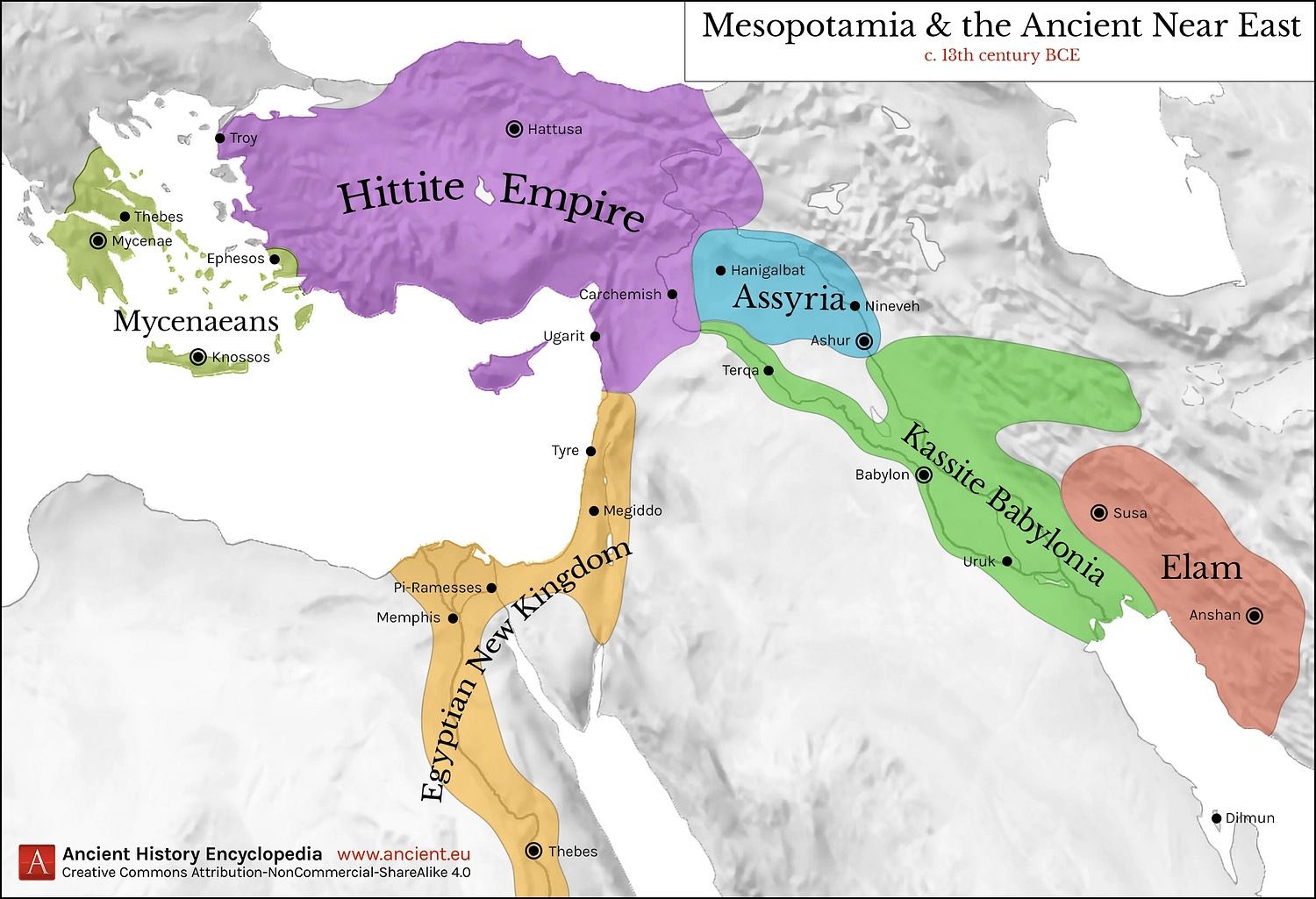
The Hittites
The Hittites were not of Middle Eastern origin. They were Indo-European herders, probably from the area around the Black Sea or between the Black and Caspian seas; these tribal peoples migrated into the Anatolian Peninsula (the area we now call Turkey) in about 2,000 BCE. They were able to create an empire through the use of technologies new to the region including bronze armor, horse-drawn chariots, and compound bows. By 1,595 BCE, they had captured Babylon and were raiding in Syria.
Hittite culture was a blend of their traditions and older Middle Eastern cultures. For example, they used cuneiform (especially for diplomatic communications and inter-regional trade contracts) as well as their own distinct pictographic script. They merged the mythologies of West Asian cultures with their own religious beliefs. They used Hammurabi’s Law Code and other Mesopotamian codes as models for their own law, but made them less severe, concentrating on restitution and compensation for wrongs done rather than retaliation. Hittite culture controlled rich mineral deposits in Anatolia which provided them iron and bronze for weapons, in addition to other resources they could export to other cultures. Trade and conquest meant Hittites became influential disseminators of West Asian ideas, languages, and technologies, contributing to the cultural mix and growth in culture, technology, and trade, of the Middle East up to 1,200 BCE.
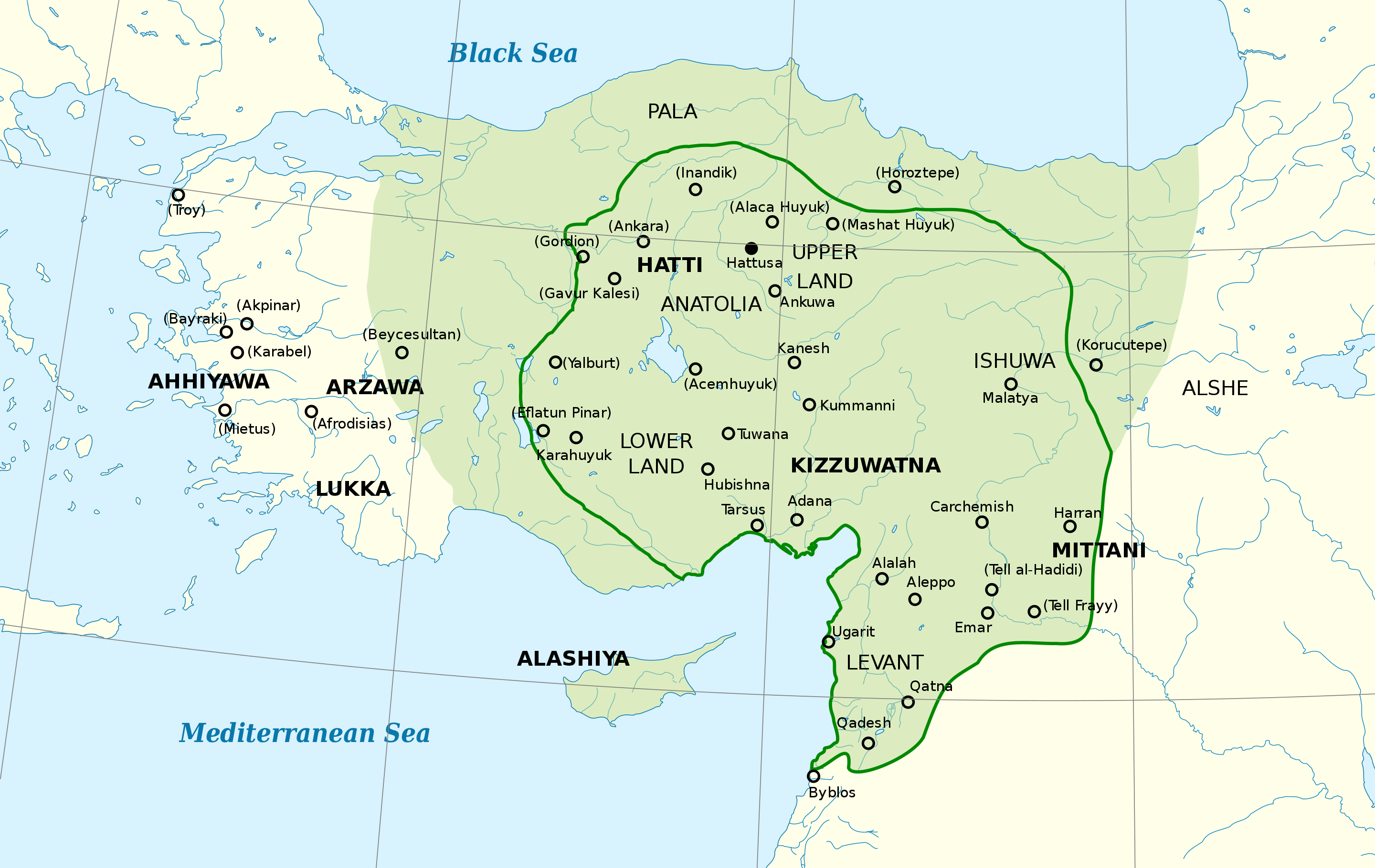
The Assyrian Empire
The Assyrians came from a small area in the northern part of Mesopotamia that was often and easily raided. Those raids taught the Assyrians much about fighting. Furthermore, raiding gave them access to metals for iron weapons. They were also exposed to the newest advances, most notably use of chariots, light 2-3 man and heavy 4-man vehicles pulled by horses. The Assyrians came up with the innovation of dividing their armies into specialized units, enabling more advanced battlefield tactics. By the 8th century BCE, the Assyrians had created a well-organized army and could field up to 500,000 soldiers armed with shields of armor, chariots, and divided into specialized units, making the army both flexible and fast. The Assyrians used these military powers to create an impressive Near Eastern empire.
The Assyrian Empire, at the height of its power from the end of the 1st millennium to the 7th century BCE, was larger than any empire that preceded it. Dominating the region, well-equipped Assyrian soldiers used their stronger iron weapons to extend the empire’s control through Mesopotamia, Syria, parts of Anatolia, Palestine, and up the Nile into Egypt. They used siege warfare, along with battering rams, tunnels, and moveable towers, to get past the defenses of cities. The Assyrians had a large army (with perhaps as many as 150,000 soldiers) that utilized a core of infantry, cavalry, as well as chariots. As part of their military strategy, the Assyrians purposefully tried to inspire fear in their enemies; they decapitated conquered kings, burnt cities to the ground, destroyed crops, and dismembered defeated enemy soldiers. One Assyrian soldier claimed:
In strife and conflict I besieged [and] conquered the city. I felled 3,000 of their fighting men with the sword…I captured many troops alive: I cut off of some of their arms [and] hands; I cut off of others their noses, ears, [and] extremities. I gouged out the eyes of many troops. I made one pile of the living [and] one of heads. I hung their heads on trees around the city. [ ] (Belibtreau 2002, np).
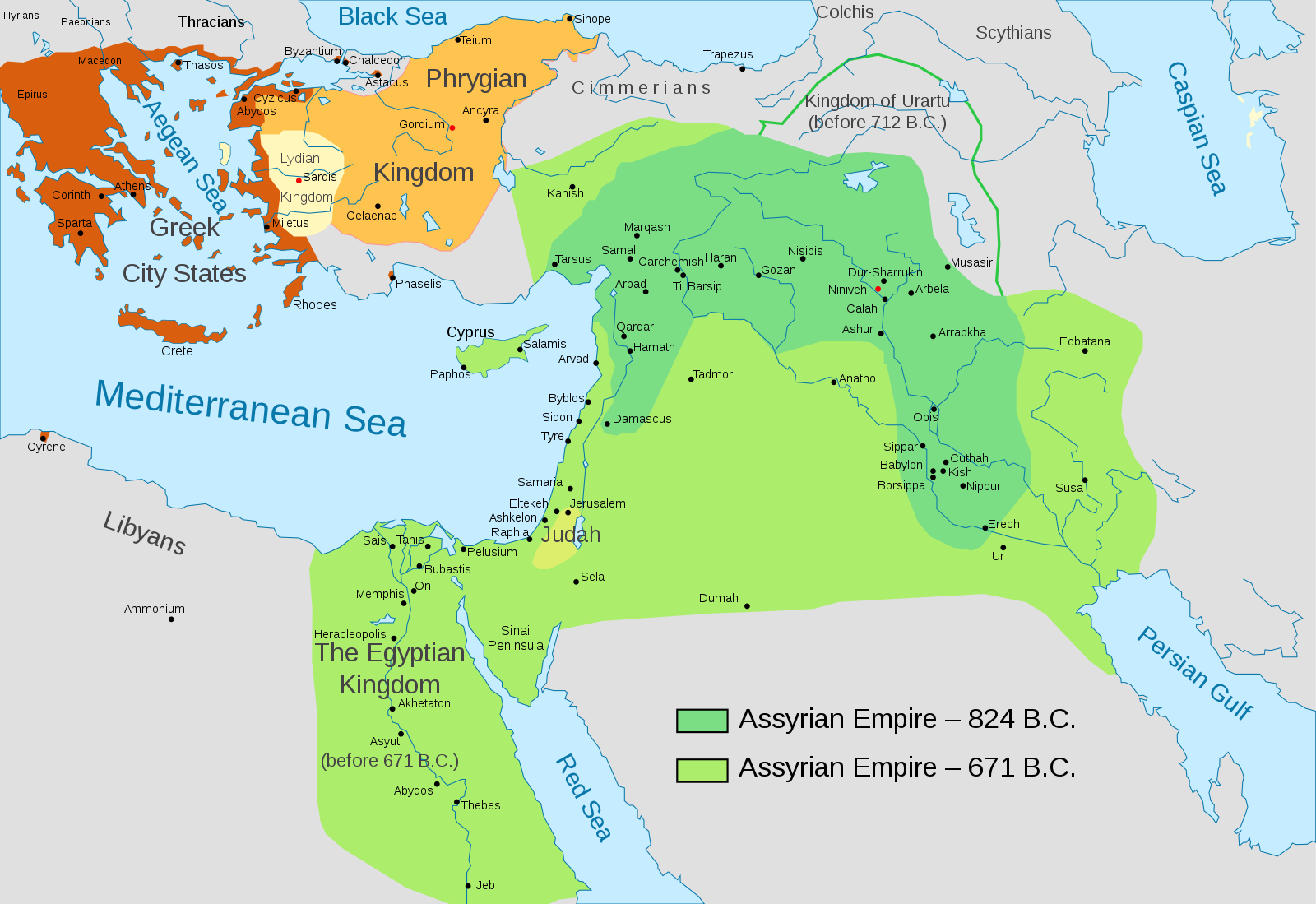
The
Assyrians expected these methods to deter potential rebellions and used their spoils of war, like precious metals and livestock, to finance further military campaigns. After conquering an area, they conscripted men into their army, and employed resettlement and deportation as techniques to get laborers where they wanted them as well as deal with communities who opposed their regime. They also collected annual tributes that were apparently high enough to, at least occasionally, spur rebellions despite the Assyrians’ reputation for violent retribution.
Much of Assyrian art appears to be what we today might call propaganda, though it was more than that. In an age when most members of society were illiterate, this was a way to communicate intentions, power, and especially legitimacy. Assyrian art glorified the power of the king. Kings were depicted as muscular and tall, warriors deserving of respect in a fierce culture. Assyrian architecture, as well as writing and art, were heavily influenced by the earlier Babylonians and Sumerians. The arches and columns of Babylonia were a common sight in Assyrian buildings.
In addition to its military strength, the Assyrian empire also stands out for the size of its cities and its administrative developments. The empire’s biggest cities, such as Nineveh and Assur, each had several million people living within them. Administratively, kings ruled Assyria, appointing governors to oversee provinces and delegates to keep tabs on the leaders of allied states. There were between 100 and 150 governors, delegates, and top officials entrusted by the king with ruling in his place and helping him maintain the empire. In the later centuries of the Assyrian Empire, kings chose these officials on the basis of merit and loyalty. Kings met with large groups of officials for rituals, festivals, and military campaigns. Evidence of such meetings has led some scholars to propose the king and his officials might have worked together in something resembling a parliamentary system, though there is no scholarly consensus on the point. Ultimately, the Assyrian Empire became too large to control; rebellions occurred with more frequency and were difficult for its overextended military to quell. The empire fell after the conquest of Nineveh in 612 BCE.
Learning in Action – Assyrian Wall Relief
View: Assyrian wall relief, The British Museum. This wall relief was dated to 730-727 BCE and was created during the rule of Tiglath-pileser III.
Link: https://www.britishmuseum.org/collection/object/W_1880-0130-7
The New Babylonian Empire (c. 626-539 BCE)
With the weakening of the Assyrian Empire, the New Babylonian Empire began to dominate Mesopotamia. Lasting for less than 100 years, the New Babylonian Empire is best known for its ruler, Nebuchadnezzar II, and its great architectural projects. As described in the Hebrew Scriptures (also known as the Old Testament), Nebuchadnezzar II, who ruled from 605–562 BCE, was a ruthless leader. He gained notoriety for destroying the city of Jerusalem and deporting many of the city’s Jews to Babylon. The captive Jews suffered in exile, as they were not allowed to return to their homeland. Nebuchadnezzar II also rebuilt Babylon with fortresses, temples, and enormous palaces. He associated the New Babylonian Empire with the glory of ancient Babylonia by reviving elements of Sumerian and Akkadian culture for example, by having artists restore ancient artwork, and celebrated the kings of old like Hammurabi.
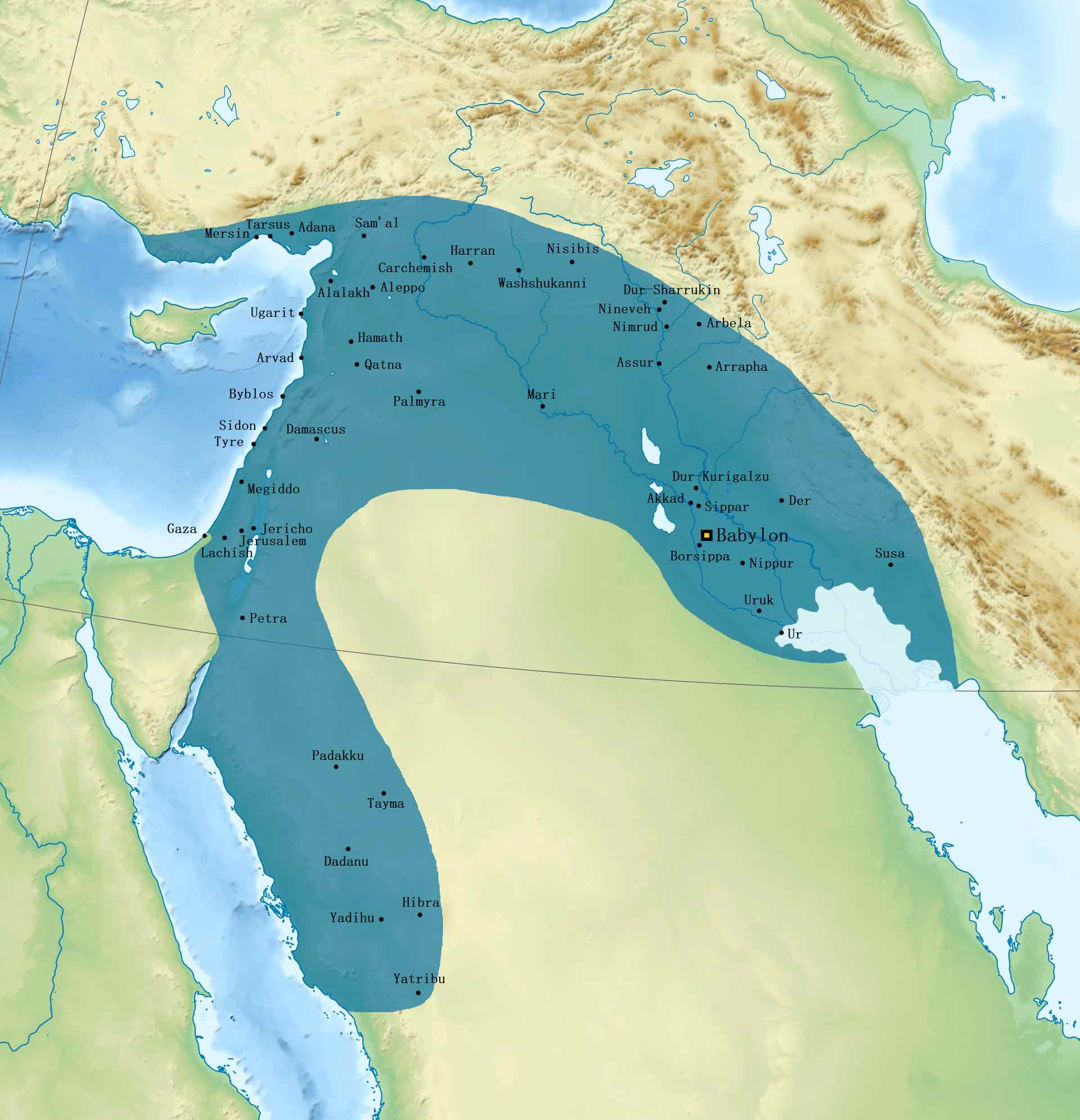
Nebuchadnezzar is often also credited with rebuilding the city’s ziggurat, Etemanaki, or the “Temple of the Foundation of Heaven and Earth.” When completed, the ziggurat rose several stories above the city and seemed to reach to the heavens. Some scholars claim that the Babylonian ziggurat was the famous Tower of Babel described in the Old Testament. Another one of Nebuchadnezzar’s purported projects, the Hanging Gardens of Babylon, was considered by the later Greek historian Herodotus to be one of the Seven Wonders of the World. According to legend, Nebuchadnezzar had the hanging gardens built for his wife. He made the desert bloom to remind her of her distant homeland; the elaborate gardens planted on rooftops and terraces were designed so that the plants’ leaves would spill down high walls. Since definitive archaeological evidence of the Hanging Gardens of Babylon has not been found, scholars continue to debate its most likely location and even its very existence. After the death of Nebuchadnezzar II, outside military pressures as well as internal conflict weakened the empire until the much larger Persian Empire conquered the New Babylonian Empire in 539 BCE.
THE ISRAELITES AND ANCIENT ISRAEL
Early Israelites
The first significant movement of Hebrew tribes took place under the leadership of the patriarch Abraham. These tribes migrated from Mesopotamian regions into the region known as Canaan sometime between 1,900-1,700 BCE. This region of Canaan was later referred to as Palestine by Roman conquerors, and in the mid-20th century became the modern state of Israel. By leading people out of Ur, his homeland in Southern Mesopotamia to eventually settle in Canaan, Abraham began the traditional history of the Israelites. According to Hebrew tradition, even before leaving Ur, Abraham taught his followers about the existence of a single creator god, and rejected the idol-worship and sin of Ur. The narrative continues to explain how when Abraham agreed to God’s directive to leave his homeland, God blessed him and all of his descendants. God entered into a covenant with Abraham. Jews recognize this covenant as indicating their special relationship with God, and it remains one of the most important aspects of the Jewish faith.
There is archeological evidence of Hebrew settlements in Canaan after about the 18th century BCE. But these settlements were abandoned sometime during the 17th century BCE (1600s BCE) as Hebrews moved again, apparently part of a larger migration of several groups moving south into the fertile Nile river valley of Egypt. This migration is attributed to environmental pressures. There is geological evidence of an extended period of drought and failed harvests in regions to the north of Egypt. Drought would have been devastating to people dependent on rain-watered agriculture, with migration a necessary response.
As the biblical text describes, the Israelites were prosperous at first and becoming powerful, leading the Egyptian pharaoh to fear their influence. To try to stem the Israelite influence, the pharaoh put restrictions on births and forced them into slave labor. According to Hebrew tradition, God tasked Moses with leading his people out of Egypt, a flight to freedom called Exodus. Moses led “the children of Israel” into Sinai, where they entered into the Sinai Covenant. This covenant bound all Israelites into a pact with God. Israelites agreed to worship God alone and obey his law, while God confirmed the place of the Israelites as his “Chosen People,” whom he would protect. As part of the covenant, Israelites agreed to follow the Ten Commandments, as well as hundreds of other laws. According to Hebrew tradition, God gave the Ten Commandments to the Israelites at Mount Sinai, instructing the Israelites to worship only him, keep the Sabbath, and honor their parents. The Ten Commandments also prohibit idolatry, blasphemy, murder, adultery, theft, dishonesty, and coveting.
These written traditions established important elements of the Jewish faith. For example, the Hebrew Scriptures trace Jewish descent from the Hebrew patriarchs: Abraham, Isaac, Israel (alternatively known as Jacob), and the twelve sons of Israel. They also describe the transition to monotheism and the covenant relationship between God and “the children of Israel.” Israelites believed in one god, Yahweh, who created and ruled over everything in the universe. Israelites generally perceived Yahweh as being just and merciful. The ideas that there is a single, universal god and that his laws apply to everyone later became defining tenets of other monotheistic religions. Subsequent written and oral traditions, like the Talmud, reflect further development of Jewish beliefs, ethics, laws, and practice.
The United Kingdom of Israel
After Exodus, the Israelites resettled in Canaan and in time began to unify. They formed kingdoms in the Levant just prior to 1000 BCE. King Saul (c. 1,030–1,009 BCE), a member of one of the Twelve Tribes of Israel, established the first Israelite monarchy, but ruled over a fairly limited territory. He was crowned king and began the process of unification, but did not completely defeat his enemies and finish unification before he died in battle with the Philistines. His son, King David, (d. 969 BCE), is often portrayed as Israel’s greatest ruler or a model king. He established the United Kingdom of Israel, with its capital at Jerusalem. King David’s successor, his son Solomon, further shaped the kingdom.
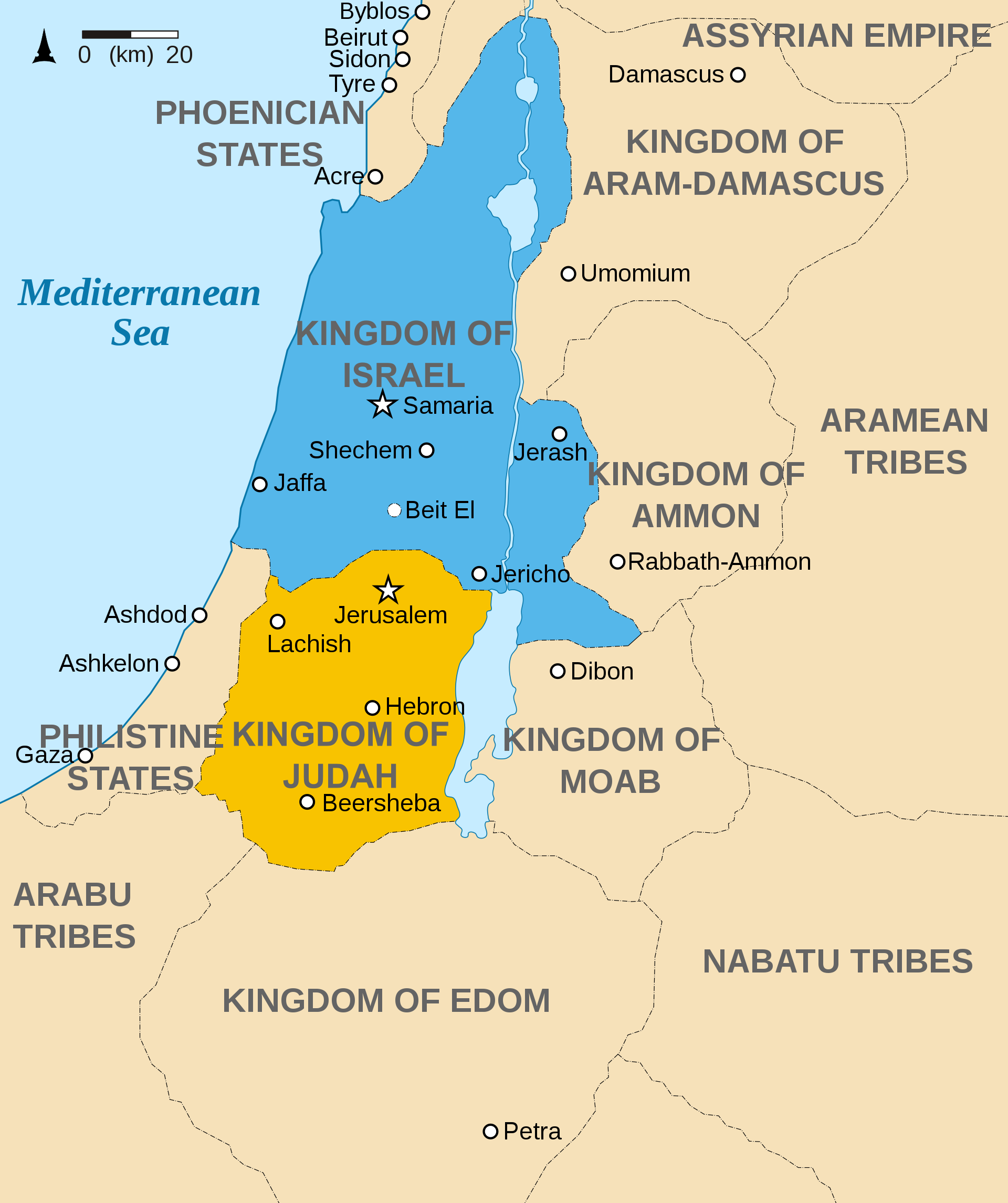
In popular memory, King David is probably most remembered for defeating Goliath. Historical traditions also celebrate him for expanding the borders of a newly unified Israel, contributing to the Book of Psalms, and, in Christian tradition, for being a forebear of Jesus. David was a “warrior king,” who defeated both internal and external enemies to unite Israel. He maintained a large standing army that helped extend his influence and create neighboring tributary states. With control of trade routes and tribute coming in from neighboring territories, Israel became a wealthy state under David. With this wealth, David began to build Jerusalem into the capital city of the Israelites, with further plans to build a temple to house the Ark of the Covenant which according to Hebrew tradition held the Ten Commandments. David died before building this temple, but tradition credits him with other achievements, including composing many of the hymns and prayers in the Book of Psalms. Like Abraham, David is considered an important figure by Jews, Christians, and Muslims.
King Solomon, David’s son, ruled a mostly peaceful realm. He accomplished his father’s goal of building the first Jewish temple in Jerusalem. The temple exemplified monumental architecture and became a focal point for the Jews of Jerusalem. Its ruins, known as the Western Wall or the Wailing Wall, are still a site of Jewish prayer and pilgrimage. Solomon also directed the building of a royal palace, a defensive wall around the city of Jerusalem, and fortresses along the kingdom’s frontier. Administratively, Solomon set up twelve districts, overseen by purveyors, who collected tribute in kind (usually as crops or foodstuffs). Each of the twelve districts was charged with supplying the king and the court for one month a year. Solomon used treaties and reciprocal trade agreements to maintain relatively peaceful relationships with Israel’s neighbors. He also forged diplomatic relations through marriage; according to scripture, he had 700 wives! After Solomon’s death, what had been the United Kingdom of Israel split into two states: Israel and Judah. Over the long term, some of Solomon’s policies, including forced labor and tributary payments, likely contributed to the divide.
After the decline of the United Kingdom of Israel, Hebrew tradition describes the significance of great prophets or teachers who spoke on behalf of god and set moral and ethical standards for the whole community. Yahweh, it was believed, sent these prophets to warn the Israelites that they were not abiding by their covenant. The prophets during this later period, especially Jeremiah and Second Isaiah, cultivated a new conceptualization of the covenant, which was much more personal as it was a relationship between Yahweh and each individual.
The Assyrians, later the Greeks, and then the Romans brought parts of the former United Kingdom of Israel under their rule. As the Assyrians approached around 745 AD, the tribes of Israel allied with Damascus to stop them. Judah and its king refused. Damascus and Israel then allied against Judah, and Judah called on the Assyrians for help. The Assyrians overran Israel and turned Judah into a subject kingdom in 722 BC. As was frequently Assyrian policy, the conquered ten northern tribes were subjected to mass deportation. They never returned to Israel. Judah survived until the Chaldeans (also known as Neo-Babylonians) under Nebuchadnezzar destroyed Jerusalem and seized 15,000 captives in the process of defeating the Assyrians and the Egyptians. The Hebrews were removed to Babylon, and the Temple razed.
During this ‘Babylonian Captivity’, Hebrews endured enforced separation from a now destroyed temple and priests were scattered. The Hebrews had to find new ways to maintain their faith. They did this through what eventually became the synagogue, and careful study of the law of God as put forth in the Pentateuch: the first five books of the Old Testament. This law eventually became codified as the Talmud. Understanding and following these scriptures became a critical part of what was now called Judaism. The people who followed this law came to be known as Jews and they set up elaborate requirements for marriage among other things as ways of assuring unity amongst themselves.

Cyrus, king of Persia, defeated the Babylonians and allowed those Jews who chose to, to return and rebuild the temple at Jerusalem about 500 BCE. Strict adherence to Talmudic law, and descent from a Jewish family became critical features of Jewish identity for those who saw themselves as unique in history. After the Persians, the Greeks under Alexander, and later the Romans also moved into these regions. Roman rule and oppression intensified between 100 BCE and 200 CE and several violent confrontations erupted between Roman imperial leaders and Hebrew populations. As a result of these conflicts many Hebrews left while others were forcibly expelled from Canaan.
Centuries of invasions – from the Babylonian Captivity to Roman control and repression – resulted in the dramatic dispersal of Hebrew peoples forced to move to other regions, referred to as the Hebrew or Jewish Diaspora; diaspora means a scattering of peoples. This conceptualization of being members of a diaspora, a scattered people who desire to return to their homeland, has played an important part in the formation of a Jewish identity. Also, in part, due to this history, preservation of cultural and religious heritage has become an enduring objective of Jews.
The Israelites left an extraordinary religious and ethical legacy. They were the first lasting monotheists, worshipping a single god, whom they referred to as Yahweh. The covenant the Hebrews established with Yahweh entailed specific and demanding duties for Jews. The laws of Yahweh were written down centuries after Exodus, beginning in the 8th century BCE. These laws include moral and ethical commands as well as strictures on diet, economic interactions and family life. The books of the Torah, together with other texts such as Proverbs and Psalms collectively became known as the ‘Written Torah’. This is the foundational religious text for Judaism. Another significant text in Judaism is the Talmud, a collection of religious scholarly teachings and precedents focused on interpreting how to understand and follow Yahweh’s laws.
Learning in Action – Judaism through its Scriptures
Watch the video: “Judaism through its Scriptures”, Harvard Online 2017
SUMMARY
In areas adjacent to the Tigris and Euphrates Rivers, Mesopotamians built city-states by 3,500 BCE. Archaeological finds and written records show the significance of the temple complex and religious leaders throughout Mesopotamia. History credits Sargon of Akkad with founding the first empire in Mesopotamia. Thereafter, a succession of empires rose and fell, demonstrating the dynamic nature of Mesopotamian societies. The unification of Egypt in approximately 3,100 BCE evidenced the emergence of a profoundly influential civilization in Northeast Africa.
Mesopotamia saw the emergence of some of the first cities and the world’s first empires. The city-states of the region, nestled near the Tigris and Euphrates Rivers, flourished from about 3,000 to 2,300 BCE. With agricultural production dependent on access to water, cities initially grew in Southern Mesopotamia near rivers, namely the Tigris and Euphrates Rivers and their tributaries. Sumerians tried to control their environment using irrigation, drainage ditches, water reserves, and other methods. With unpredictable floods and other environmental challenges, the Sumerians viewed nature as hostile and their expectations of the afterlife tended to be pessimistic. Their understanding of nature as unpredictable also spurred engineering innovations as Sumerians prepared for floods, water shortages, and other natural events. While farming was the mainstay of their economies, city-states were also involved in robust long-distance trade networks, which allowed them to garner the many resources not available in their region. Kingship, with hereditary rulers who claimed control over multiple city-states and special relationships with the gods, was just one significant political innovation in the region. Sargon of Akkad and subsequent rulers built empires, expanding their control and influence over even larger territories. These city-states alternately allied with, competed against, and waged war on one another, with kingship emerging as rulers dominated multiple city- states. As evidenced by the centrality of temples and the belief that kingship came from heaven, religion was of fundamental importance to these societies.
Archeologists have also uncovered ample evidence of social stratification and labor specialization in these ancient city-states. Archeologists have been able to recognize Sumerian developments, in part, because the Sumerians left behind a wealth of information documented in cuneiform, one of the world’s first written scripts. Scholars have begun to describe life in ancient Sumerian societies and appreciate the many Sumerian achievements, like those in math, where they introduced a computation system based on 60, which we still use to divide time and in geometry as a circle has 360°. Sumerians were innovators, creating the first known cities, the first systems of writing, achieving notable achievements in engineering and architecture and more. While Sumerian traditions influenced developments throughout the region, other cities and cultures emerged and refined their own institutions and beliefs. Researchers have found evidence of significant cultural links between the Mesopotamian city-states and later civilizations including the Hittites and Assyrians.
The ancient Egyptians made numerous contributions to world history. We remember them for mummification, their pharaohs, and the pyramids. The Egyptians were heavily dependent on and thankful for the annual Nile River floods which renewed the soil in the floodplains. Bountiful harvests and agricultural surplus enabled the Egyptians to develop a wide variety of craft specializations, one of which was the practice of mummification. The practice of mummification was intricately tied to Egyptian beliefs about the afterlife and was practiced for over 2000 years.
According to Hebrew Tradition, Abraham led his Israelite followers from the city of Ur in Mesopotamia and they eventually settled in the Levant. Several generations later, again based on Hebrew Tradition, the Israelites went to Egypt where they suffered persecution and enslavement, until Moses liberated them. Upon their return to Canaan, the Israelites built kingdoms just prior to 1000 BCE. Their kingdoms formed complex administrations and were unified by powerful kings, such as the well- known King Solomon. Historians also recognize countless other contributions made by the Israelites, especially related to monotheistic religious traditions.
While polytheism was dominant in this region of the world, the Israelites developed their own monotheistic faith focused on a single god, Yahweh. Judaism emerged as a revolutionary departure from the norm of polytheism, the dominant religious belief in the ancient world. The Jewish religion was based on a monotheistic belief in one god, Yahweh. Judaism is also based on the belief Hebrews are the chosen people of this one true god; they are defined as a people, as a culture, by their shared duty to follow the laws of Yahweh, to maintain the covenant as it was affirmed during Exodus and interpreted by later prophets and rabbis. Fulfillment of expectations based on this covenant are fundamental bases of Judaism, a globally influential monotheistic tradition.
WORKS CITED AND FURTHER READING
- “Ancient Egypt: Egyptian Mummies.” n.d. Smithsonian. Accessed July 28, 2023. https://www.si.edu/spotlight/ancient-egypt/mummies.
- Baden, Joel. 2014. The Historical Hero: The Real Life of an Invented Hero. New York: Harper One.
- Belibtreu, Erika. 1991. “Grisly Assyrian Record of Torture and Death.” Biblical Archaeology Review 17 (1). https://faculty.uml.edu//ethan_Spanier/Teaching/documents/CP6.0AssyrianTorture.pdf.
- Bellows, Sierra. 2010. “The Trouble with Civilization: Ancient Cities Reveal the Vulnerabilities of Modern Societies.” Virginia Magazine, Fall 2010. https://uvamagazine.org/articles/the_trouble_with_civilization/.
- Brown, Cynthia Stokes. 2009. “What Is a Civilization, Anyway?” World History Connections 6 (3). https://worldhistoryconnected.press.uillinois.edu/6.3/brown.html.
- Budge, Wallis E.A., trans. 1923. “A Hymn of Praise of Her-Aakhuti.” In Tutankhamen: Amenism, Atenism and Egyptian Monotheism. New York: Dodd, Mead & Co.
- Clark, Peter, ed. 2013. The Oxford Handbook of Cities in World History. New York: Oxford University Press.
- “Cuneiform Tablet: Loan of Silver.” n.d. The Metropolitan Museum of Art. Accessed June 28, 2023. https://www.metmuseum.org/art/collection/search/325858.
- David, Rosalie. n.d. The Pyramid Builders of Ancient Egypt: A Modern Investigation of Pharaoh’s Workforce. New York: Routledge.
- Dever, William. 2012. The Lives of Ordinary People in Ancient Israel: Where Archaeology and the Bible Intersect. Grand Rapids, MI: William B. Eerdman’s Publishing Company.
- Egypt Tombs Suggest Pyramids Not Built by Slaves.” 2010. Reuters. January 11, 2010. https://www.reuters.com/article/us-egypt-antiquities-tombs/egypt-tombs-suggest-pyramids-not-built-by-slaves-idUSTRE6091E720100111.
- German, Senta. n.d. “Ziggurat of Ur.” Khan Academy. Accessed June 28, 2023. https://www.khanacademy.org/humanities/ancient-art-civilizations/ancient-near-east1/x7e914f5b:neo-sumerian-ur-iii/a/ziggurat-of-ur.
- Gershon, Livia. 2021. “Oldest ʻIndustrial-Scaleʻ Brewery Found in Egypt,” February 16, 2021. https://www.smithsonianmag.com/smart-news/worlds-oldest-industrial-scale-brewery-found-egypt-180977026/.
- Gordon, Wenham. n.d. Exploring the Old Testament: A Guide to the Pentateuch. Illinois: InterVarsity Press.
- “Governors, Diplomats and Soldiers in the Service of Sargon II and Tiglath-Pileser III, Kings of Assyria.” n.d. History Department, University College London. Accessed June 28, 2023. https://www.ucl.ac.uk/sargon/.
- “Great Hymn to Aten, c. 2100 BCE.” 2000. Ancient History Sourcebook. 2000. https://sourcebooks.fordham.edu/ancient/hymn-nile.asp.
- Hawkins, Ralph. 2013. How Israel Became a People. Nashville, TN: Abindon Press.
- “Herodotus: Mummification, from The Histories.” 2000. Ancient History Sourcebook. 2000. https://sourcebooks.fordham.edu/ancient/herodotus-mummies.asp.
- “Hierakonpolis.” n.d. Hierakonpolis. Accessed July 28, 2023. http://www.hierakonpolis-online.org/.
- “Hymn to the Nile, c. 2100 BCE.” 2000. Ancient History Sourcebook. 2000. https://sourcebooks.fordham.edu/ancient/hymn-nile.asp.
- Johnson, Janet H. 2002. “Women’s Legal Rights in Ancient Egypt.” Fathom Archive, Digital Collections. University of Chicago Library. 2002. https://fathom.lib.uchicago.edu/1/777777190170/.
- Kilmer, Anne Draffkorn Kilmer. 1998. “The Musical Instruments from Ur and Ancient Mesopotamian Music.” Expedition, 1998. https://www.penn.museum/sites/expedition/the-musical-instruments-from-ur-and-ancient-mesopotamian-music/.
- King, L.W., trans. n.d. “The Code of Hammurabi, c. 1780 BCE.” Fordham University. Ancient History Sourcebook. Accessed June 28, 2023. https://legacy.fordham.edu/halsall/ancient/hamcode.asp#text.
- Kramer, Samuel. 1963. The Sumerians: Their History, Culture, and Character. Chicago: Chicago University Press.
- Leick, Gwendolyn. 2004. Mesopotamia: The Invention of the City. London: Penguin Books.
- Marks, Tasha. 2018. “A Sip of History: Ancient Egyptian Beer.” British Museum Blog (blog). May 25, 2018. https://blog.britishmuseum.org/a-sip-of-history-ancient-egyptian-beer/.
- McDowell, A.G. 1999. Village Life in Ancient Egypt: Laundry Lists and Love Songs. Oxford.
- Milstein, Mati. 2010. “King Solomon’s Wall Found – Proof a Bible Tale?” National Geographic, February 27, 2010. https://www.nationalgeographic.com/history/article/100226-king-solomon-wall-jerusalem-bible.
- Mitchell, William. December. “The Hydraulic Hypothesis: A Reappraisal.” Current Anthropology 15 (5): 532–34.
- Pinch, Geraldine. 2004. Egyptian Mythology: A Guide to the Gods, Goddesses, and Traditions of Ancient Egypt. Oxford.
- Postgate, J.N. 1994. Early Mesopotamia: Society and Economy at the Dawn of History. London: Routledge.
- Sandars, N.K., trans. 1972. The Epic of Gilgamesh. Third. Penguin Classics. https://college.cengage.com/history/primary_sources/world/epic_gilgamesh.htm.
- ———, ed. n.d. “The Story of the Blood.” In The Epic of Gilgamesh. Assyrian International News Agency Books Online. Accessed June 28, 2023. http://www.aina.org/books/eog/eog.pdf.
- Shanks, Hershel, ed. 2010. Ancient Israel: From Abraham to the Roman Destruction of the Temple. Third. Washington, DC: Biblibal Archaeology Society.
- Shaw, Ian. n.d. The Oxford History of Ancient Egypt. Oxford: Oxford University Press.
- Shillington, Kevin. n.d. History of Africa. Vol. Second. Oxford: Macmillan Education.
- Spar, Ira. 2009. “Gilgamesh.” Heilbrunn Timeline of Art History (blog). April 2009. https://www.metmuseum.org/toah/hd/gilg/hd_gilg.htm.
- Teeter, Emily. n.d. Religion and Ritual in Ancient Egypt. Cambridge: Cambridge University Press.
- “The Underworld and the Afterlife in Ancient Egypt.” n.d. Australian Museum. https://australian.museum/learn/cultures/international-collection/ancient-egyptian/the-underworld-and-the-afterlife-in-ancient-egypt/.
- Tyldesley, Joyce. n.d. Daughters of Isis:Women in Ancient Egypt. New York: Penguin History.
- Wenham, Gordon J. 2003. Exploring the Old Testament: A Guide to the Pentateuch. Illinois: InterVarsity Press.
- Wilson, Elizabeth. 2006. “The Queen Who Would Be King.” Smithsonian Magazine, 2006. https://www.smithsonianmag.com/history/the-queen-who-would-be-king-130328511/.
- Wilson, John A., trans. n.d. “The Great Hymn to the Aten.” The Akhet-Aten Home Page. https://katherinestange.com/egypt/hymn2.htm.
-
Wu, Katherine. 2020. “Ancient Egyptian Funeral Home Reveals Embalmers Had a Knack for Business.” Smithsonian Magazine, May 7, 2020. https://www.smithsonianmag.com/smart-news/ancient-egyptian-funeral-home-reveals-embalmers-had-knack-business-180974823/.

